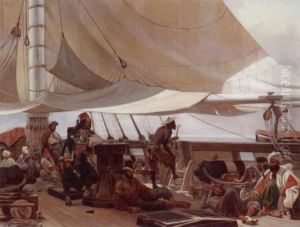Wilhelmine Friderike Louise Paintings
Wilhelmine Friderike Louise, commonly known as Queen Louise of Prussia, was not an artist in the traditional sense, but her influence on the cultural and political climate of her time, as well as her representation in the arts, has left a marked legacy. Born on March 10, 1774, in Hanover, Germany, Louise was the daughter of Prince Charles of Mecklenburg-Strelitz and his wife, Princess Frederica of Hesse-Darmstadt.
Louise is perhaps best known for her role as Queen consort of King Frederick William III of Prussia, whom she married in 1793. As queen, she was celebrated for her beauty, grace, and kindness. Although she did not produce art herself, she was a patron and supporter of the arts and played a significant role in the cultural life of Prussia. Louise was particularly influential in the areas of fashion and courtly etiquette, setting standards that were emulated throughout the German states.
Her life, however, was not without hardship. Louise lived through tumultuous times, including the Napoleonic Wars, which greatly affected Prussia. She was praised for her patriotic spirit and efforts to support her country during the French occupation. After Prussia's defeat at the Battle of Jena-Auerstedt in 1806, Louise, along with her husband and children, had to flee Berlin. She became a symbol of resistance against Napoleon and was involved in the reform movement in Prussia, advocating for changes that would strengthen the state.
Louise's premature death on July 19, 1837, in Hohenzieritz, Kingdom of Prussia, was deeply mourned. She was remembered as a symbol of national unity and an idealized figure of motherhood and virtue. Her legacy continued to influence Prussian and later German culture, and she became a romanticized figure in German history.
In the arts, Louise has been commemorated through various portraits and sculptures, with artists capturing her regal yet gentle demeanor. Her life and image have inspired literature, music, and even film, ensuring that her influence extends well beyond her lifetime. While Queen Louise of Prussia was not an artist, her impact on the arts and her enduring place in history make her a figure of great interest in the study of art history and the cultural narrative of her era.
